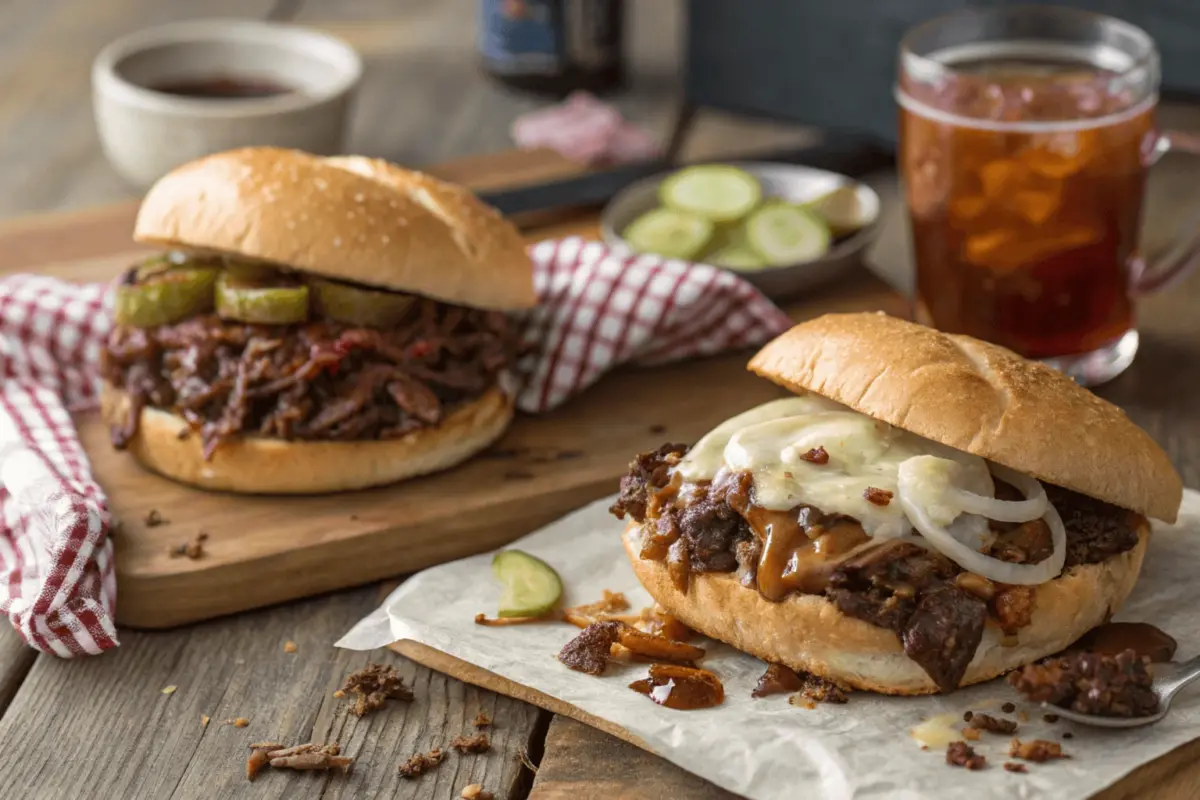Introduction
Let’s face it, sandwiches are more than just a quick meal—they’re a slice of culinary history. Among the most iconic options, chopped beef and cheesesteak stand out for their unique flavors, textures, and loyal followings. Whether you prefer the smoky simplicity of chopped beef or the rich indulgence of a cheesesteak, these sandwiches have a way of stealing the spotlight. But what makes them so different? This guide dives into the origins, ingredients, and what sets a chopped beef sandwich apart from a cheesesteak, helping you understand why both deserve a spot on your plate.
The Origins of Chopped Beef and Cheesesteak
Historical Background of Chopped Beef
Chopped beef sandwiches have roots in Texas barbecue culture, where beef brisket reigns supreme. The dish likely started as a way to repurpose leftover brisket, with pitmasters chopping it up, mixing it with barbecue sauce, and piling it onto buns. Over time, it evolved into a staple of Southern cuisine, often enjoyed during outdoor gatherings and cookouts. Learn more about its evolution in chopped beef sandwich.
How Cheesesteak Emerged in Philadelphia
On the other hand, the cheesesteak hails from Philadelphia, Pennsylvania, where it was born in the 1930s. Legend has it that Pat Olivieri, a hot dog vendor, decided to throw some sliced beef on his grill one day. A passing cab driver caught a whiff and asked for a sandwich, and the rest is history. Adding cheese came later, creating the indulgent combination we know and love today.
Ingredients: The Building Blocks of Flavor
Core Ingredients in Chopped Beef Sandwiches
When it comes to chopped beef sandwiches, simplicity meets bold flavor. The main attraction is slow-smoked brisket, which is known for its tender texture and rich, smoky taste. After hours of cooking, the brisket is chopped into juicy pieces that practically melt in your mouth. To take it a step further, the meat is mixed with a tangy barbecue sauce that balances sweetness, spice, and acidity perfectly. Soft, pillowy buns complete the sandwich by soaking up the sauce and holding everything together. For an extra layer of flavor, some versions include pickles or sliced onions, adding crunch and a hint of tanginess.
Essential Components of a Cheesesteak
The cheesesteak, on the other hand, thrives on indulgent and hearty ingredients. It begins with thinly sliced ribeye steak, a cut chosen for its marbling and tenderness. As the steak cooks on a hot griddle, caramelized onions are often added to enhance its natural sweetness. Next, cheese is introduced—whether sharp provolone, creamy American, or the iconic Cheez Whiz—which melts into the steak, creating a gooey, savory combination. Finally, all of this deliciousness is tucked into a sturdy, crusty roll that adds structure while soaking up the juices. Each bite is a harmonious blend of textures and flavors that keeps you coming back for more.
Preparation Methods: Chopped Beef vs. Cheesesteak

Cooking Techniques for Chopped Beef
Chopped beef sandwiches are all about low-and-slow cooking. Brisket, the cornerstone of this dish, is smoked for hours—sometimes up to 12 or more—until it’s incredibly tender. The meat is then chopped finely, often with a cleaver for that rustic texture, and mixed with barbecue sauce. The sauce keeps the beef moist and adds a punch of flavor. Toss it onto a buttered bun, and you’re ready to dig in.
Cheesesteak’s Grilling and Assembly Process
Making a cheesesteak requires quick, precise steps that bring out its signature flavors. The process begins by slicing ribeye steak paper-thin, which ensures it cooks quickly on a hot griddle. While the steak sizzles, onions caramelize alongside it, blending their sweetness with the savory meat. Cheese melts directly onto the steak, infusing it with rich, gooey goodness. Finally, the cooked ingredients are scooped into a sturdy roll, creating a sandwich that holds all the flavors together. Every step highlights the cheesesteak’s balance of tender steak, melty cheese, and hearty bread.
Texture and Appearance
Visual and Textural Characteristics of Chopped Beef
Chopped beef sandwiches are rustic and hearty. The meat, chopped into uneven pieces, creates a texture that’s both chunky and tender. When mixed with barbecue sauce, it has a glossy, rich appearance that practically screams comfort food. The buns are soft and squishy, soaking up the juices without falling apart.
What Defines a Cheesesteak’s Texture?
Cheesesteaks, on the other hand, are all about that gooey, melty vibe. The steak is thin and tender, with just the right amount of chew. The onions bring a slight crunch, balancing out the softness of the cheese and bread. The crusty roll adds a satisfying bite, holding everything together no matter how messy it gets. It’s a textural mix that keeps you coming back for more.
Flavor Profiles: A Culinary Contrast
Savory Notes of Chopped Beef
Chopped beef sandwiches deliver a smoky, savory punch. The brisket’s natural beefiness is amplified by the slow-smoking process, with barbecue sauce adding layers of tangy sweetness or heat, depending on the recipe. The balance of smoky and saucy flavors makes every bite comforting yet bold.
Cheesesteak’s Rich and Indulgent Taste
Cheesesteaks are unapologetically rich. The ribeye steak is naturally flavorful, with its fat melting into the meat as it cooks. The cheese, whether sharp provolone or creamy Cheez Whiz, adds a layer of decadence. Grilled onions give the sandwich a hint of sweetness, tying the whole flavor experience together in one indulgent bite.
Regional Popularity and Cultural Significance
Chopped Beef in Urban Food Culture
Chopped beef sandwiches are a staple in Texas and the Southern United States. They’re a go-to item at barbecue joints, food trucks, and even church picnics. In urban areas, they’ve gained a reputation as hearty comfort food, often served with pickles, coleslaw, or potato salad. It’s a dish that brings people together, whether at a backyard cookout or a bustling diner.
Cheesesteak as a Philadelphia Staple
The cheesesteak is virtually synonymous with Philadelphia, and it’s more than just a sandwich—it’s a cultural icon. Locals passionately debate which spot serves the best version, whether it’s Pat’s, Geno’s, or a lesser-known gem tucked away around the corner. Moreover, this classic dish embodies the city’s blue-collar roots and its proud, unpretentious food culture. As a result, tourists flock to Philly to experience it firsthand, making it an absolute must-try for anyone visiting the area.
Variations and Regional Twists
Unique Takes on Chopped Beef Sandwiches
Chopped beef sandwiches might be rooted in Texas barbecue, but there’s no shortage of creative spins. Some versions swap out traditional barbecue sauce for spicy mustard or even salsa for a Tex-Mex flair. Others use brioche buns or pretzel rolls for a gourmet touch. You’ll also find chopped beef sliders at parties and game-day spreads, proving this classic can adapt to any occasion.
Cheesesteak Variants Across the United States
While the original Philly cheesesteak is iconic, regional twists abound. In California, you might find avocado or hot peppers added. In Chicago, some spots experiment with giardiniera for a tangy kick. Even vegan versions with plant-based “steak” and dairy-free cheese have carved out a niche. These variations keep the cheesesteak spirit alive while appealing to diverse tastes.
Health and Nutrition: A Comparative Perspective
Caloric and Nutritional Breakdown of Chopped Beef
Chopped beef sandwiches are hearty, but they can pack a caloric punch. Depending on the serving size and sauce, a typical sandwich might clock in around 400-600 calories. The brisket is high in protein but also rich in fat, especially when paired with buttery buns. Choosing a leaner cut or a lighter sauce can help balance the indulgence with a bit of health-consciousness.
Analyzing the Cheesesteak’s Nutritional Value
Cheesesteaks are undeniably rich. A single sandwich often contains 800-1,200 calories, depending on the portion size and cheese choice. The ribeye steak provides protein and iron, but the added cheese and bread make it a high-fat, high-carb meal. If you’re watching your intake, consider splitting one with a friend—it’s still plenty satisfying.
Popular Pairings and Side Dishes
Best Accompaniments for Chopped Beef
Chopped beef sandwiches shine when paired with classic barbecue sides. Think creamy coleslaw, baked beans, or cornbread to round out the meal. If you want something lighter, a simple green salad with a tangy vinaigrette can help balance the richness of the sandwich.
Cheesesteak’s Classic Sides and Drinks
When it comes to cheesesteaks, fries are the ultimate sidekick. Crinkle-cut, curly, or straight—they all work. Some folks love dipping their fries into a little extra cheese sauce for good measure. A cold soda or a frothy beer completes the experience, making it a comfort food feast.
Availability and Price Points
Where to Find Chopped Beef Sandwiches
Chopped beef sandwiches are easy to find in barbecue joints, especially in the South and Midwest. Many food trucks and roadside stands also serve them, often at budget-friendly prices. Expect to pay $5-$10 for a sandwich, depending on the location and portion size.
Cheesesteak Accessibility and Pricing
Cheesesteaks are a staple at diners, sandwich shops, and even some fast-food chains across the country. In Philadelphia, they’re everywhere—from corner delis to upscale restaurants. Prices vary, but most fall between $8-$15, with gourmet versions costing a bit more. No matter where you are, chances are a cheesesteak isn’t too far away.
FAQs
What’s the difference between chopped steak and Philly cheesesteak?
Chopped steak is usually ground or finely chopped beef, often shaped into a patty or served as a standalone dish with gravy. Philly cheesesteak, on the other hand, uses thinly sliced ribeye steak, cooked with onions, and topped with cheese, all served in a crusty roll. They’re totally different flavor and texture experiences.
What’s the difference between ground beef and chopped beef?
Ground beef is finely minced meat, often used in burgers, tacos, or casseroles. Chopped beef refers to larger, irregular pieces of beef, typically from a smoked brisket, used in barbecue sandwiches. The texture of chopped beef is chunkier, while ground beef is much finer.
What’s the difference between a Philly cheesesteak and a cheesesteak?
A Philly cheesesteak refers specifically to the original version of this sandwich created in Philadelphia. It traditionally features thinly sliced ribeye steak, grilled onions, and a choice of cheeses—typically Cheez Whiz, provolone, or American—served on a long, crusty roll. The term “cheesesteak,” on the other hand, is broader and can include regional or modern variations that deviate from the classic Philly style. For instance, some versions outside Philadelphia might use different cuts of beef, add non-traditional toppings like peppers or mushrooms, or even experiment with types of bread. While all Philly cheesesteaks are cheesesteaks, not every cheesesteak sticks to the authentic Philadelphia recipe.
What cut of beef is used for cheesesteaks?
Ribeye is the go-to cut for authentic cheesesteaks. It’s tender, flavorful, and has just enough fat to stay juicy during cooking. Some variations might use sirloin or other cuts, but ribeye is the classic choice.
Conclusion
When it comes to sandwiches, both chopped beef and cheesesteak hold their own as true crowd-pleasers. Chopped beef brings the unmistakable smoky flavors of barbecue, offering a hearty, rustic meal that’s perfect for any casual gathering. On the other hand, the cheesesteak is a rich and indulgent masterpiece, blending tender steak, gooey cheese, and a satisfying crunch from the roll. With each bite, these sandwiches tell their unique culinary stories. If you’re in the mood for smoky comfort, chopped beef is your go-to. Craving something indulgent and savory? A cheesesteak never disappoints. Ultimately, the choice depends on what your taste buds are asking for that day. But why choose just one? These sandwiches are delicious in their own right and worth trying whenever you get the chance. So, next time you’re hungry, let curiosity guide you and enjoy the best of both worlds.
Discover more inspiration for lunch recipes here.


1 thought on “Chopped Beef vs. Cheesesteak: Key Differences You Should Know”